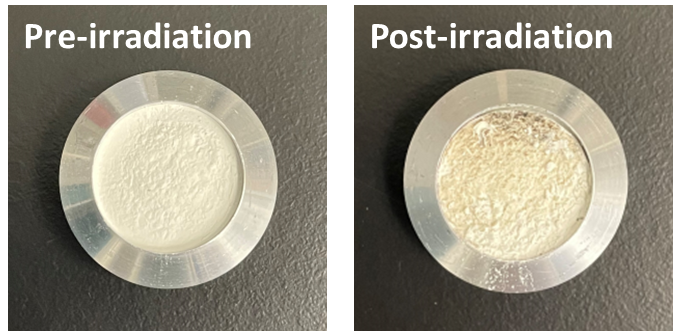Reproducing space weathering on olivine via ion irradiation
- 1Pennsylvania State University, College of Engineering, Nuclear Engineering, University Park, PA, United States of America (camilo@psu.edu)
- 2Planetary Science Institute, Tucson, AZ, United States of America
- 3Columbia Astrophyisics Laboratory, Columbia University, New York City, NY, United States of America
Introduction: The Toolbox for Research and Exploration (TREX) is a NASA SSERVI (Solar System Exploration Research Virtual Institute) node. TREX (trex.psi.edu) aims to develop tools and research methods for the exploration of airless bodies, specifically the Moon, the Martian moons, and near-Earth asteroids. TREX studies are organized into four Themes: (1) Laboratory studies, (2) Lunar studies, (3) Small bodies studies, and (4) Field work. The work presented here is part of Theme 3: Investigations of fine-grained materials on the surface of small bodies.
Background: Reflectance spectroscopy is a widely used technique to study planetary bodies in our solar system, partly because its ability to identify compositional characteristics via remote sensing [1]. It has been shown that reflectance spectra of minerals on the surface of airless bodies can exhibit differences in their spectral characteristics, when compared to laboratory measurements of their Earth analogs [2]. This is because minerals exposed to the interplanetary environment are constantly subject to particle and electromagnetic radiation, and micrometeorite bombardment, which gradually alter their chemical and physical properties, a process called space weathering. To accurately interpret reflectance spectra from remote observations, it is key to fully understand how space weathering alters the spectral characteristics of minerals.
Laboratory studies are a powerful tool to simulate space-weathering-like processes and unravel the fate of minerals exposed to space-like radiation and micrometeorite impact environments. Such studies give access to additional characterization environments that can further our understanding of micrometeorite- and radiation-material interactions. In this work, we conduct ion irradiation experiments to evaluate the evolution of minerals exposed to a solar wind-like environment
Methods: For this work, olivine grains were ground into loose powders (<25 µm) to generate regolith-like samples. The powders were produced in a glovebox under a nitrogen environment (water and oxygen content <1 ppm). This procedure enabled us to generate olivine grains with fresh faces that were not previously exposed to air. The prepared samples were transferred to IGNIS (Ion-Gas-Neutrals Interactions with Surfaces) –a vacuum irradiation and characterization facility– in a portable sample capsule [3]. Throughout the experiment, from the sample preparation, to transport, irradiation, and characterization, the samples were never exposed to air, preventing any alterations due to interactions with the atmosphere.
In IGNIS, the olivine loose powders were exposed to ion beams to simulate mineral exposure to solar wind ions. The irradiations were performed using hydrogen and argon ions, at fluences up to 1x1018 ions cm-2. X-ray photoelectron spectroscopy (XPS) and reflectance spectroscopy were performed in situ to assess the influence of ion bombardment on the surface chemistry and the reflectance spectra characteristics. By performing sample characterization in situ, the evolution of the surfaces under ion bombardment was tracked with high fidelity, by minimizing the influence of air exposure on the sample’s characteristics.
Preliminary results: Olivine powders irradiated with 1 keV argon ions, to a fluence of 1x1017 ions cm-2 exhibit a clear alteration of their optical properties. A darkening of the sample was evident by direct inspection of the powders before and after irradiation (Figure 1). The irradiation was carried out in steps; XPS and reflectance spectra were collected between steps, at 1x1016, 2x1016, 5x1016 and 1x1017 ions cm-2. The collected reflectance spectra show a darkening trend of the olivine samples with increasing irradiation fluence (Figure 2). The change in the albedo of the olivine powders with increasing fluence exhibited a wavelength dependence, with a more pronounced darkening towards the UV. The depth of the absorption band at 1.05 µm, characteristic of olivine spectra, were also altered with the ion irradiation.

Figure 1. Darkening of olivine powders observed after 1 keV Ar+ irradiation with a dose of 1017ions cm-2
Figure 2 Ultraviolet-visible reflectance spectra of olivine powders irradiated with 1 keV Ar+. The sample darkening is evident by the overall decreased reflectance.
References: [1] Cloutis, E.A., et al. (2018) Primitive Meteorites and Asteroids: Physical, Chemical, and Spectroscopic Observations Paving the Way to Exploration, Elsevier, 273-343. [2] Adams, J.B. and Jones, R.L. (1970) Science, 737-739. [4] Jaramillo, C. et al. (2021) AGU Fall meeting, P11A-06
How to cite: Jaramillo-Correa, C., Clark, R. N., Domingue, D. L., Pearson, N., Savin, D. W., Vilas, F., Allain, J. P., and Hendrix, A. R.: Reproducing space weathering on olivine via ion irradiation, Europlanet Science Congress 2022, Granada, Spain, 18–23 Sep 2022, EPSC2022-735, https://doi.org/10.5194/epsc2022-735, 2022.